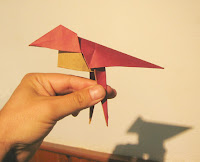
I gave in a little too easily a few posts ago to the claim that a bird base doesn’t conveniently allow a two-winged, split back without pre-placement of grafts, etc. Actually here, the desires of the origami designer to show what can be done with points come into conflict with nature’s aesthetics, since most of the time birds are standing around, their wings and tail really are conjoined in one streamlined, seamless unit. But supposing you do insist on showing wing-tips as points—it is not necessary to have them be fully independent. It’s enough to indicate the separation. And if so, a bird base is perfectly adequate to the task.
In fact now that I’ve been around the world, so to speak, with fancy bases and fancy variations to them, I keep coming back to simpler things. The traditional bases turn out to do the job better than the fancy ones! Here is that damn plain-vanilla Bird Base again. And this time I think I can illustrate the idea of continuous complexity directly with this model:
Basically, the moves are:
1. Bird base
2. Color reverse one face of the base
3. Rabbit-ear the other (colored) side around the paper’s squared-off center, while sticking a finger to open the pocket underneath
4. Color-reverse the head too--by loosening the paper almost all the way, making a shallow rabbit-ear, then closing the whole assembly again.

In diagrams here is where you would be in about 10 steps:
One could, in fact, stop hereabouts, or slightly afterward, and have a perfectly reasonable ‘childish’ model. Or perhaps one can think of this as an embryonic stage.
But even if you don’t stop, you should at least pause here, and let the purity and cleanliness of these surfaces and lines sink into
 your soul. The expanse of unmarked paper, held flat or curving, that shows paper for what it is; and the few long folds, where origami can be seen in its fundamentals. Whatever you do from this point on is going damage the purity of the form. --That may very well be necessary, but you’ll want to minimize the damage, and weigh the benefits of every choice against its cost. Anyone incapable of feeling pain at what about to be lost here will never be more than a technical folder.
your soul. The expanse of unmarked paper, held flat or curving, that shows paper for what it is; and the few long folds, where origami can be seen in its fundamentals. Whatever you do from this point on is going damage the purity of the form. --That may very well be necessary, but you’ll want to minimize the damage, and weigh the benefits of every choice against its cost. Anyone incapable of feeling pain at what about to be lost here will never be more than a technical folder.To complexify, you might decide to point-split feet, split open a beak, cut the tail into virtual wings plus a tail, ornament the tail further, put feathers on the wings or whatnot. What should guide these choices? There’s a tendency, in today’s testosterone-driven origami, to do what’s technically more difficult, or at least more elaborate, so that you get these scales of complexity: if there are claws, then there must also to be an open beak, wings detached from the joint, etc. etc.
I humbly suggest that restraining one’s gonads here is the wiser course. In design it is generally asked what is the most you can make out of the material you have at hand. That makes perfect sense. But it can also be reasonable to ask, what is the least you can make of it, and still have something worthwhile. For the ratio of means to ends is what finally gets considered, not the absolute values of each. That is the rule for art in general; and for origami, which is all about the Something-from-Nothing, it is true all the more.
* * *
The Sparrow up top is my first experience folding at home with Origamido paper. Boy is it a pleasure! I wish I could afford it! It's what we'll all be folding with in the Origami Afterlife.
Let me wish Michael LaFosse and Richard Alexander a smooth transition to their new quarters in Honolulu. I was born in Boston, even if I don’t live there now, and as a native let me say: this departure is a real loss for the city and for the entire U.S. East Coast. Bon Voyage regardless.
Happy holidays everyone.

[Added 10.29.07]